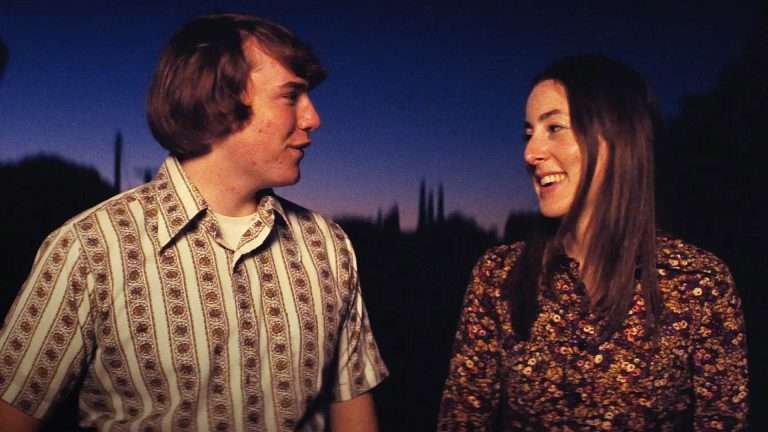Cinematic space has the potential to transcend the limited four borders of the frame and go beyond, and sometimes, even become haptic. Cinema can use this tool of space to narrate and express the ineffable. Pushpendra Singh’s “Laila Aur Satt Geet” (“The Shepherdess and the Seven Songs,” 2020) finely exploits the usage of space in such a way that it becomes a character in itself. I stumbled upon this film a few years ago and was taken aback upon seeing how the cinematic space becomes the protagonist of the film which becomes possible because of the masterful handling of the formal aspects of cinema and how the character of Laila serves as an extended metaphor of the protagonist, which is the place itself.
The mesmerising cinematography and the well-crafted direction allow the observer to look in awe at the camera angles, the beautiful landscapes, and the rhetorical and spatial character of the film. The opening establishes the connection of the place with the narrative by presenting a low-angle shot of the montane forest, and the film ends with the naked figure of the female protagonist slowly and gradually getting lost and liberated in the forest, and it ends with the shot of a mountain top beginning to bathe in sunshine.
The seven songs, or “satt geet,” constituting Kashmiri folk songs are sutured with seven chapters, each consisting of different moods of the narrative focusing on the character of Laila, with such precision that the music and lyrics become the driving factor of the narrative. The music drives the film and becomes the primary narrative mode, along with the internal monologues that are mostly superimposed on the existing music score. The first strokes of the sarod are heard in a frontal scene of the character of Laila, who appears for the first time, where she breaks the fourth wall and stares directly at the spectator right after Tanvir’s successful lifting of the stone, which will soon result in the marriage of Laila and Tanvir.
Laila looks at us with a stoic expression accompanied by the background strokes of the Sarod that questions the patriarchal structure wherein her marriage gets finalised with the man who can lift an apparently heavy stone. Repeated shots of the beautiful landscapes of Kashmir have been amalgamated with the ‘geet’ to enunciate the importance of space in the narrative. Before the beginning of each chapter, there are repeated shots of the place with a few or no human characters.
Herds of sheep could be seen always wandering around and heightening the beauty of the place in itself, which forms the leitmotif of the film. Even at the end of the prologue, we see an eye-catching shot of Laila and Tanvir sitting together in the forest, and suddenly, the character of Tanvir gets replaced by a sheep. This sudden jerk adds to the meaning of the film about how it is a subversion of the anthropocentric world, and that gets clear upon watching the film completely.
Laila’s beauty captures the attention of the whole village of Tanvir, and soon everybody starts talking about her. The local guard and even the officer start to set “traps” to “experience the new flower of the town.” This reminds us of the ever-existing threat that Kashmir faces from its neighbouring places. Laila becomes rebellious and beats up the officer and explains to her husband that those needed a few thrashings and that since the people of the village are so helpless and quiet that they get the scope to harass them. Despite trying hard to capture Laila, the guard keeps on falling ‘in the trap of Laila,’ time and again, just like the falling of the truck from the cliffs of the mountain which we hear in the news from a radio device of Tanvir and his group’s when they embarked on the journey towards their hometown with Laila.

Repeated monologues of Laila clarify how she feels about her surroundings and the people accompanying it, and her thirsts and desires, and how she comes to realise and think beyond these mortal tendencies, which becomes literal in the last chapter, or ‘geet.’ Although Laila fantasizes about the guard in her dreams and monologues since Tanvir doesn’t satisfy her sexually, she does not fall for his lust and desires. Laila’s dissatisfaction and unfulfilled desires visually culminate in a shot of a tree whose inside is burning, which can be described as the best frame of the film for its power and craft.
The encounter of Laila with a snake, which is shedding its skin, marks the turning point in the narrative, which constitutes the last chapter, or ‘ geet,’ named Song of Realization. Laila keeps the dead skin with her and starts introspecting her behaviours and moods. The dead skin becomes the carrier of the migratory leitmotif of the film. It symbolises the recurrent theme of metamorphosis and migration that motivates the narrative and makes us remember Lalla’s song, stating the migratory aspect of human beings. The mystic Lalla’s song deals with the movement of human beings for ages; how they have been travelling from place to place from birth to death, while the beauty or the content of the place remains the same and exists there, which is unknown to humankind, much like the state of Kashmir.
This reminds us of the contemporary American philosopher Thomas Nail, who works on migration and movement theories, and his view of migration not as an exception but as the rule, which is taken to an extreme in his book “The Figure of the Migrant,” where we see the migrant as a political character. Snakes shed their skin by going to another place and then coming back to their place. Their shedding sites remain the same, where most of the time they come back to do the same. As Lalla says, it is the place that experiences the changes. We hear about the national border and identities of the villagers, which remain blurry because of their non-existent national identity cards.
This precisely is the point, which is that a person cannot be bound to a certain geographical position. Human beings are and always have been migratory since their evolution; otherwise, the invention of the wheel would not have taken place, and we would not require transport for that matter. This constructed structure of positioning people in a certain geographical location and binding them is being questioned on the scene where we see the villagers deferring the creation of government-approved ID cards, and it gets further literal when we see the guard not being able to locate Laila’s identity. With the ongoing as well as perennial Indo-Pak tension and the recurring capitalist stances that we are facing, “Laila Aur Satt Geet” and my argument that I present here become even more relevant.
The liberation of the character of Laila at the very end serves as an epiphany accompanied by a Kashmiri folk song, “Take me away.” We see Laila finally identifying and recognising herself right after watching the snake shedding its skin. Laila takes out the skin, wears it around her, and then walks out of the house. The camera follows her and shows her dress falling off, only to present an establishing shot of the mountain region where Laila goes further into the beautiful landscape.
She does not occupy much space in the frame and isn’t the subject anymore. The landscape and its beauty become an important factor, thus finally establishing Laila as the personification of the space in itself. Just like the state of Kashmir, Laila evades the structured schema set by the capitalistic and patriarchal society by neither staying with the man she is ‘supposed to’ stay with nor by becoming the ‘infidel.’ Rather, Laila finds her comfort in the splendid beauty of the place and transcends beyond the mortal to immerse herself in the nature and the beauty of it by ‘shedding’ her robes and coverings and going naked into the forest.









My interest in Laila Aur Satt Geet has been piqued after reading this article. Wonderful and incisive observation by the writer. The trope of using space as a character harkens back to Thomas Hardy’s fictional Wessex, the backdrop in most of his works.